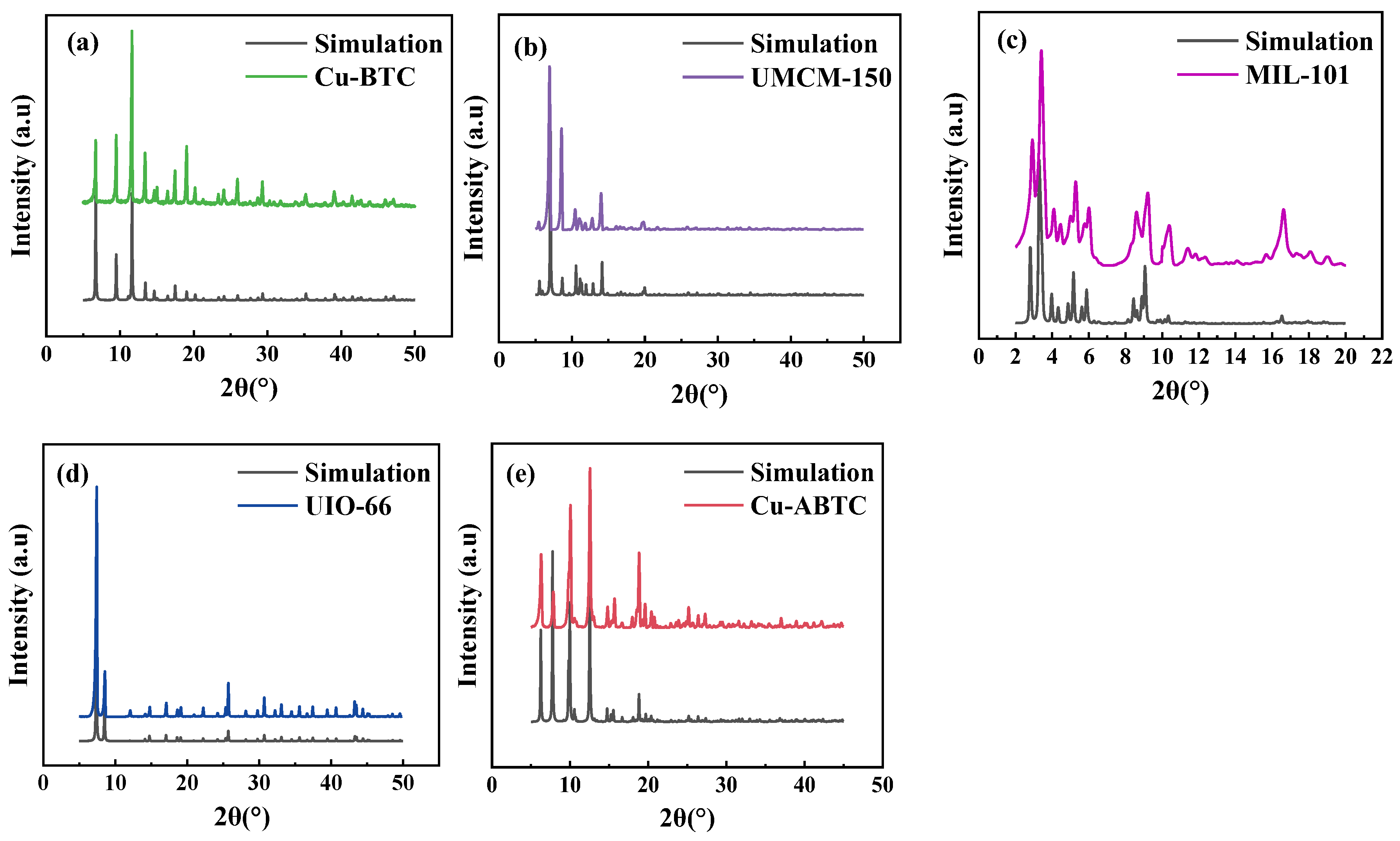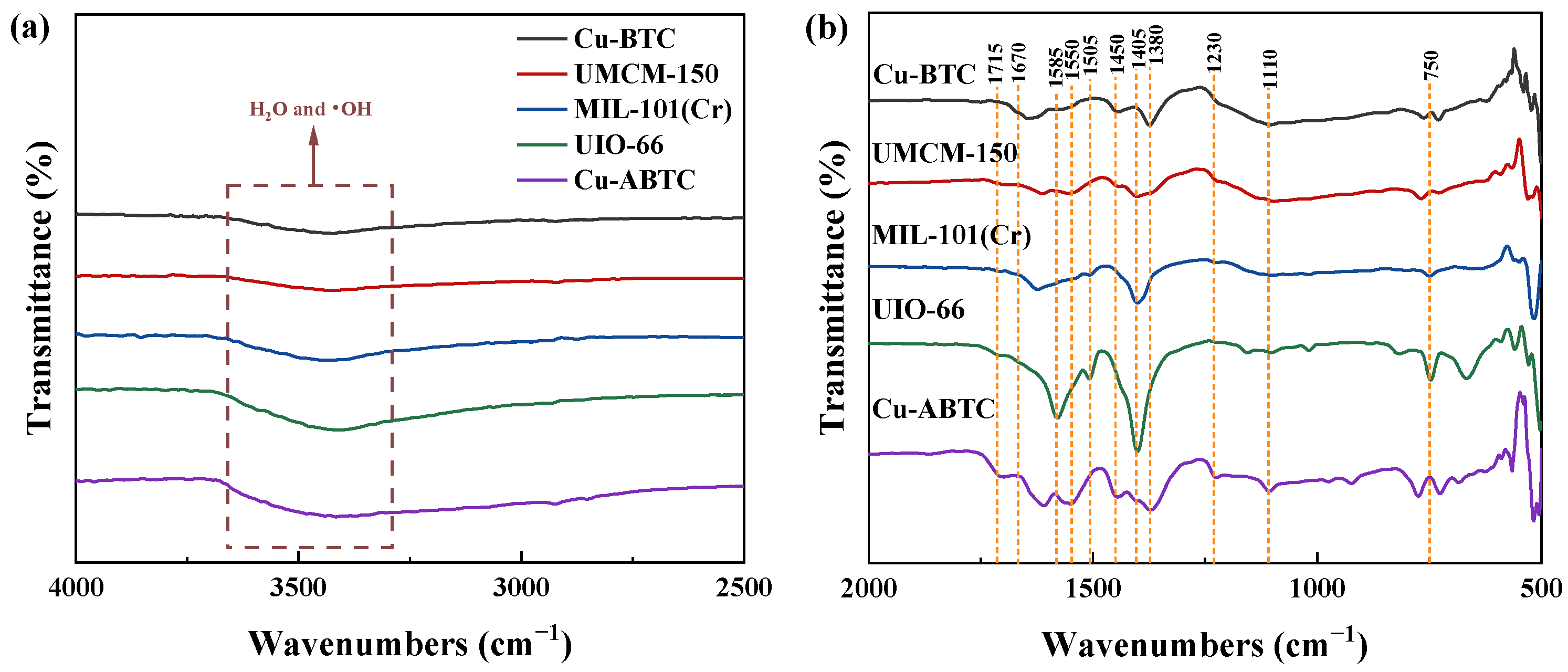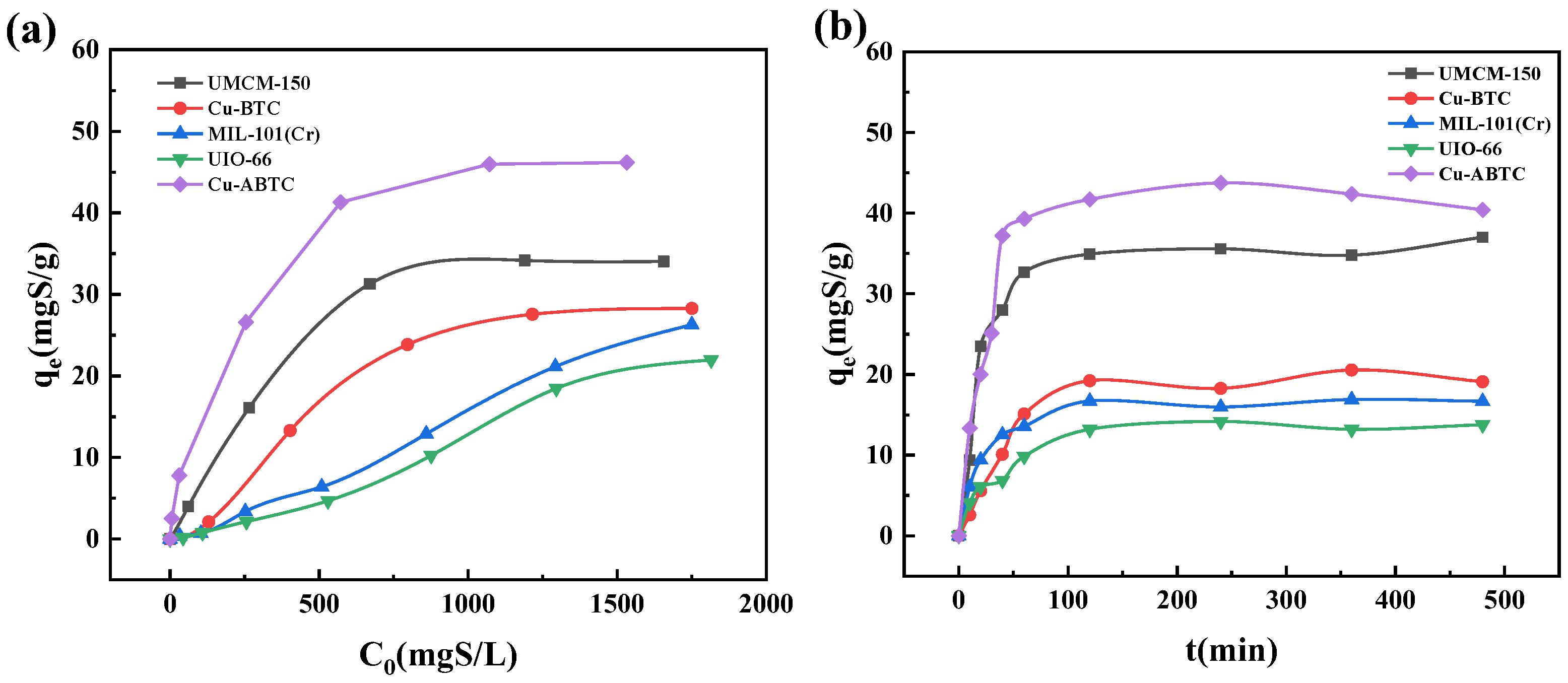Dibenzothiophene Removal from Fuel Oil by Metal-Organic Frameworks: Performance and Kinetics
Abstract
1. Introduction
2. Materials and Methods
2.1. Reagents
2.2. Synthesis of the Five MOFs
2.3. DBT Adsorption Procedure
2.4. Characterization and Analytical Method
3. Results and Discussion
3.1. Characterization of Five MOFs
3.2. Performances of DBT Adsorption
3.3. Kinetics of DBT Adsorption
3.4. Adsorption Condition Optimization
4. Conclusions
Author Contributions
Funding
Institutional Review Board Statement
Informed Consent Statement
Data Availability Statement
Conflicts of Interest
References
- Srivastava, V.C. An evaluation of desulfurization technologies for sulfur removal from liquid fuels. RSC Adv. 2012, 2, 759–783. [Google Scholar] [CrossRef]
- Lu, P.; Yin, M.; Chen, J.; Wang, Q.; Ye, C.; Qiu, T. ZiF-8-derived P, N-co-doped hierarchical carbon: Synergistic and high-efficiency desulfurization adsorbents. Chem. Eng. J. 2022, 429, 132458. [Google Scholar] [CrossRef]
- Wang, R.; Yu, F.; Zhang, G.; Zhao, H. Performance evaluation of the carbon nanotubes supported Cs2.5H0.5PW12O40 as efficient and recoverable catalyst for the oxidative removal of dibenzothiophene. Catal. Today 2010, 150, 37–41. [Google Scholar] [CrossRef]
- Saha, B.; Vedachalam, S.; Dalai, A.K. Review on recent advances in adsorptive desulfurization. Fuel Process. Technol. 2021, 214, 106685. [Google Scholar] [CrossRef]
- Zhang, Y.H.; Liu, M.Q.; Liu, M.M.; Zhao, L.; Gao, J.S.; Xu, C.M.; Gao, X.H.; Liu, X.Q. Fundamental research on the influence of mercaptan and thioether structure on the solvent extraction of fluid catalytic cracking naphtha. Sep. Purif. Technol. 2021, 270, 118747. [Google Scholar] [CrossRef]
- Haruna, A.; Merican, Z.M.A.; Musa, S.G. Recent advances in catalytic oxidative desulfurization of fuel oil—A review. J. Ind. Eng. Chem. 2022, 112, 20–36. [Google Scholar] [CrossRef]
- Haruna, A.; Merican, A.M.Z.; Gani, M.S.; Abubakar, S. Sulfur removal technologies from fuel oil for safe and sustainable environment. Fuel 2022, 329, 125370. [Google Scholar] [CrossRef]
- Abro, R.; Abdeltawab, A.A.; Al-Deyab, S.S.; Yu, G.; Qazi, A.B.; Gao, S.; Chen, X. A review of extractive desulfurization of fuel oils using ionic liquids. RSC Adv. 2014, 4, 35302–35317. [Google Scholar] [CrossRef]
- Soleimani, M.; Bassi, A.; Margaritis, A. Biodesulfurization of refractory organic sulfur compounds in fossil fuels. Biotechnol. Adv. 2007, 25, 570–596. [Google Scholar] [CrossRef]
- Luna, M.D.G.; Samaniego, M.L.; Ong, D.C.; Wan, M.W.; Lu, M.C. Kinetics of sulfur removal in high shear mixing-assisted oxidative-adsorptive desulfurization of diesel. J. Clean. Prod. 2018, 178, 468–475. [Google Scholar] [CrossRef]
- Tran, D.T.; Palomino, J.M.; Oliver, S.R.J. Desulfurization of JP-8 jet fuel: Challenges and adsorptive materials. RSC Adv. 2018, 8, 7301–7314. [Google Scholar] [CrossRef] [PubMed]
- Zheng, M.; Chen, J.; Zhang, L.; Cheng, Y.; Lu, C.; Liu, Y.; Singh, A.; Trivedi, M.; Kumar, A.; Liu, J. Metal organic frameworks as efficient adsorbents for drugs from wastewater. Mater. Today. Commum. 2022, 31, 103514. [Google Scholar] [CrossRef]
- Zhong, Y.Y.; Chen, C.; Liu, S.; Lu, C.Y.; Liu, D.; Pan, Y.; Sakiyama, H.; Muddassir, M.; Liu, J.Q. A new magnetic adsorbent of eggshell-zeolitic imidazolate framework for highly efficient removal of norfloxacin. Dalton Trans. 2021, 50, 18016–18026. [Google Scholar] [CrossRef]
- Zhou, S.H.; Lu, L.; Liu, D.; Wang, J.; Sakiyama, H.; Muddassir, M.; Nezamzadeh, A.; Liu, J.Q. Series of highly stable Cd(II)-based MOFs as sensitive and selective sensors for detection of nitrofuran antibiotic. CrystEngComm 2021, 23, 8043–8052. [Google Scholar] [CrossRef]
- Pan, Y.; Rao, C.Y.; Tan, X.L.; Ling, Y.; Singh, A.; Kumar, A.; Li, B.H.; Liu, J.Q. Cobalt-seamed C-methylpyrogallol 4 arene nanocapsules-derived magnetic carbon cubes as advanced adsorbent toward drug contaminant removal. Chem. Eng. J. 2022, 433, 133857. [Google Scholar] [CrossRef]
- Zhang, Y.; Li, G.; Kong, L.; Lu, H. Deep oxidative desulfurization catalyzed by Ti-based metal-organic frameworks. Fuel 2018, 219, 103–110. [Google Scholar] [CrossRef]
- Cychosz, K.A.; Wong-Foy, A.G.; Matzger, A.J. Liquid phase adsorption by microporous coordination polymers: Removal of organosulfur compounds. J. Am. Chem. Soc. 2008, 130, 6938–6939. [Google Scholar] [CrossRef]
- Khan, N.A.; Jhung, S.H. Low-temperature loading of Cu+ species over porous metal-organic frameworks (MOFs) and adsorptive desulfurization with Cu+-loaded MOFs. J. Hazard. Mater. 2012, 237–238, 180–185. [Google Scholar] [CrossRef]
- Huang, M.; Chang, G.; Su, Y.; Xing, H.; Zhang, Z.; Yang, Y.; Ren, Q.; Bao, Z.; Chen, B. A metal-organic framework with immobilized Ag(i) for highly efficient desulfurization of liquid fuels. Chem. Commun. 2015, 51, 12205–12207. [Google Scholar] [CrossRef]
- Shi, F.; Hammoud, M.; Thompson, L.T. Selective adsorption of dibenzothiophene by functionalized metal organic framework sorbents. Appl. Catal. B 2011, 103, 261–265. [Google Scholar] [CrossRef]
- Li, J.; Yang, Z.; Hu, G.; Zhao, J. Heteropolyacid supported MOF fibers for oxidative desulfurization of fuel. Chem. Eng. J. 2020, 388, 124325. [Google Scholar] [CrossRef]
- Mguni, L.L.; Yao, Y.; Ren, J.; Liu, X.; Hildebrandt, D. Modulated synthesized Ni-based MOF with improved adsorptive desulfurization activity. J. Clean. Prod. 2021, 323, 129196. [Google Scholar] [CrossRef]
- Chu, L.; Guo, J.; Wang, L.; Liu, H.; Yan, J.; Wu, L.; Yang, M.; Wang, G. Synthesis of defected UIO-66 with boosting the catalytic performance via rapid crystallization. Appl. Organomet. Chem. 2022, 36, e6559. [Google Scholar] [CrossRef]
- Vakili, R.; Gholami, R.; Stere, C.E.; Chansai, S.; Fan, X. Plasma-assisted catalytic dry reforming of methane (DRM) over metal-organic frameworks (MOFs)-based catalysts. Appl. Catal. B Environ. 2019, 260, 118195. [Google Scholar] [CrossRef]
- Wang, S.; Liu, J.; Pulido, B.; Li, Y.; Mahalingam, D.; Nunes, S.P. Oriented zeolitic imidazolate framework (ZIF) nanocrystal films for molecular separation membranes. ACS Appl. Nano Mater. 2020, 3, 3839–3846. [Google Scholar] [CrossRef]
- Huo, Q.; Li, J.; Qi, X.; Liu, G.; Zhang, X.; Zhang, B.; Ning, Y.; Fu, Y.; Liu, J.; Liu, S. Cu, Zn-embedded MOF-derived bimetallic porous carbon for adsorption desulfurization. Chem. Eng. J. 2019, 378, 122106. [Google Scholar] [CrossRef]
- Wong-Foy, A.G.; Lebel, O.; Matzger, A.J. Porous crystal derived from a tricarboxylate linker with two distinct binding motifs. J. Am. Chem. Soc. 2007, 129, 15740–15741. [Google Scholar] [CrossRef]
- Qiu, J.; Feng, Y.; Zhang, X.; Jia, M.; Yao, J. Acid-promoted synthesis of UiO-66 for highly selective adsorption of anionic dyes: Adsorption performance and mechanisms. J. Colloid Interface Sci. 2017, 499, 151–158. [Google Scholar] [CrossRef]
- Xue, M.; Zhu, G.S.; Li, Y.X.; Zhao, X.J.; Jin, Z.; Kang, E.; Qiu, S.L. Structure, hydrogen storage, and luminescence properties of three 3D metal-organic frameworks with NbO and PtS topologies. Cryst. Growth Des. 2008, 8, 2478–2483. [Google Scholar] [CrossRef]
- Hu, X.; Liu, X.; Zhang, X.; Chai, H.; Huang, Y. One-pot synthesis of the CuNCs/ZIF-8 nanocomposites for sensitively detecting H2O2 and screening of oxidase activity. Biosens. Bioelectron. 2018, 105, 65–70. [Google Scholar] [CrossRef]
- Qin, L.; Liang, F.L.; Li, Y.; Wu, J.A.; Guan, S.Y.; Wu, M.Y.; Xie, S.L.; Luo, M.S.; Ma, D.Y. A 2D porous zinc-organic framework platform for loading of 5-fluorouracil. Inorganics 2022, 10, 202. [Google Scholar] [CrossRef]
- Qin, L.; Li, Y.; Liang, F.; Li, L.; Lan, Y.; Li, Z.; Lu, X.; Yang, M.; Ma, D. A microporous 2D cobalt-based MOF with pyridyl sites and open metal sites for selective adsorption of CO2. Microporous Mesoporous Mater. 2022, 341, 112098. [Google Scholar] [CrossRef]
- Deng, L.; Lu, B.; Li, J.; Lv, G.; Du, S.; Shi, J.; Yang, Y. Effect of pore structure and oxygen-containing groups on adsorption of dibenzothiophene over activated carbon. Fuel 2017, 200, 54–61. [Google Scholar] [CrossRef]
- Huang, M.; Mi, K.; Zhang, J.; Liu, H.; Yu, T.; Yuan, A.; Kong, Q.; Xiong, S. MOF-derived bi-metal embedded N-doped carbon polyhedral nanocages with enhanced lithium storage. J. Mater. 2017, 5, 266–274. [Google Scholar] [CrossRef]
- Aliyu, M.; Azhar, A.; Arief, C. Cation exchange in metal-organic frameworks (MOFs): The hard-soft acid-base (HSAB) principle appraisal. Inorg. Chim. Acta 2020, 511, 119801. [Google Scholar]
- Zheng, S.; Sun, Y.; Xue, H.; Braunstein, P.; Huang, W.; Pang, H. Dual-ligand and hard-soft-acid-base strategies to optimize metal-organic framework nanocrystals for stable electrochemical cycling performance. Natl. Sci. Rev. 2022, 9, 197. [Google Scholar] [CrossRef]
- Saleh, T.A.; Danmaliki, G.I. Adsorptive desulfurization of dibenzothiophene from fuels by rubber tyres-derived carbons: Kinetics and isotherms evaluation. Process. Saf. Environ. Prot. 2016, 102, 9–19. [Google Scholar] [CrossRef]
- Li, X.; Mao, Y.; Leng, K.; Ye, G.; Sun, Y.; Xu, W. Enhancement of oxidative desulfurization performance over amorphous titania by doping MIL-101(Cr). Microporous Mesoporous Mater. 2017, 254, 114–120. [Google Scholar] [CrossRef]
- Liu, J.; Li, X.M.; He, J.; Wang, L.Y.; Lei, J.D. Combining the photocatalysis and absorption properties of core-shell Cu-BTC@TiO2 microspheres: Highly efficient desulfurization of thiophenic compounds from fuel. Materials 2018, 11, 2209. [Google Scholar] [CrossRef]
- Yc, A.; Jyl, B.; Djlab, C. Thermodynamic parameters for adsorption equilibrium of heavy metals and dyes from wastewaters: Research updated—Sciencedirect. Bioresour. Technol. 2016, 222, 513–516. [Google Scholar]






| MOFs | SBET (m2/g) | Vtotal (cm3/g) |
|---|---|---|
| MIL-101(Cr) | 2413.76 | 1.19 |
| UMCM-150 | 2114.34 | 1.14 |
| Cu-ABTC | 1588.49 | 0.83 |
| Cu-BTC | 1078.95 | 0.55 |
| UIO-66 | 993.96 | 0.53 |
| MOFs | Pseudo-First-Order | Pseudo-Second-Order | |||||
|---|---|---|---|---|---|---|---|
| qe,exp (mgS/g) | qe,cal (mgS/g) | k1 (min−1) | R2 | qe,cal (mgS/g) | k2 g/(mgS·min) | R2 | |
| Cu-ABTC | 43.74 | 13.32 | 0.0075 | 0.5191 | 42.55 | 0.0024 | 0.9947 |
| Cu-BTC | 20.55 | 9.65 | 0.0049 | 0.4844 | 21.83 | 0.0010 | 0.9824 |
| UMCM-150 | 37.00 | 11.18 | 0.0065 | 0.5156 | 37.74 | 0.0017 | 0.9970 |
| MIL-101(Cr) | 16.89 | 7.34 | 0.0076 | 0.9406 | 17.33 | 0.0038 | 0.9989 |
| UIO-66 | 14.16 | 6.95 | 0.0061 | 0.7632 | 14.62 | 0.0025 | 0.9943 |
| 293K | 298K | 303K | ||
|---|---|---|---|---|
| 34.067 | 145.328 | −8.527 | −9.211 | −9.981 |
Disclaimer/Publisher’s Note: The statements, opinions and data contained in all publications are solely those of the individual author(s) and contributor(s) and not of MDPI and/or the editor(s). MDPI and/or the editor(s) disclaim responsibility for any injury to people or property resulting from any ideas, methods, instructions or products referred to in the content. |
© 2023 by the authors. Licensee MDPI, Basel, Switzerland. This article is an open access article distributed under the terms and conditions of the Creative Commons Attribution (CC BY) license (https://creativecommons.org/licenses/by/4.0/).
Share and Cite
Chen, H.; Huang, Z.; You, J.; Xia, Y.; Ye, J.; Zhao, J.; Zhang, S. Dibenzothiophene Removal from Fuel Oil by Metal-Organic Frameworks: Performance and Kinetics. Int. J. Environ. Res. Public Health 2023, 20, 1028. https://doi.org/10.3390/ijerph20021028
Chen H, Huang Z, You J, Xia Y, Ye J, Zhao J, Zhang S. Dibenzothiophene Removal from Fuel Oil by Metal-Organic Frameworks: Performance and Kinetics. International Journal of Environmental Research and Public Health. 2023; 20(2):1028. https://doi.org/10.3390/ijerph20021028
Chicago/Turabian StyleChen, Han, Zhipeng Huang, Juping You, Yinfeng Xia, Jiexu Ye, Jingkai Zhao, and Shihan Zhang. 2023. "Dibenzothiophene Removal from Fuel Oil by Metal-Organic Frameworks: Performance and Kinetics" International Journal of Environmental Research and Public Health 20, no. 2: 1028. https://doi.org/10.3390/ijerph20021028
APA StyleChen, H., Huang, Z., You, J., Xia, Y., Ye, J., Zhao, J., & Zhang, S. (2023). Dibenzothiophene Removal from Fuel Oil by Metal-Organic Frameworks: Performance and Kinetics. International Journal of Environmental Research and Public Health, 20(2), 1028. https://doi.org/10.3390/ijerph20021028











